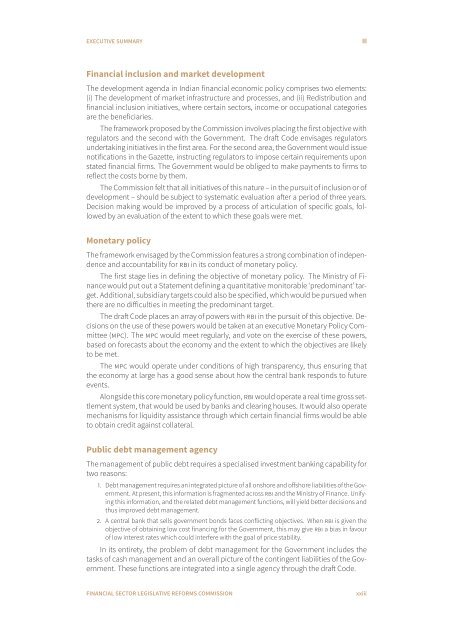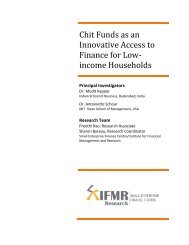Government of India Volume I: Analysis and Recommendations
Government of India Volume I: Analysis and Recommendations
Government of India Volume I: Analysis and Recommendations
Create successful ePaper yourself
Turn your PDF publications into a flip-book with our unique Google optimized e-Paper software.
EXECUTIVE SUMMARY<br />
Financial inclusion <strong>and</strong> market development<br />
The development agenda in <strong>India</strong>n financial economic policy comprises two elements:<br />
(i) The development <strong>of</strong> market infrastructure <strong>and</strong> processes, <strong>and</strong> (ii) Redistribution <strong>and</strong><br />
financial inclusion initiatives, where certain sectors, income or occupational categories<br />
are the beneficiaries.<br />
The framework proposed by the Commission involves placing the first objective with<br />
regulators <strong>and</strong> the second with the <strong>Government</strong>. The draft Code envisages regulators<br />
undertaking initiatives in the first area. For the second area, the <strong>Government</strong> would issue<br />
notifications in the Gazette, instructing regulators to impose certain requirements upon<br />
stated financial firms. The <strong>Government</strong> would be obliged to make payments to firms to<br />
reflect the costs borne by them.<br />
The Commission felt that all initiatives <strong>of</strong> this nature – in the pursuit <strong>of</strong> inclusion or <strong>of</strong><br />
development – should be subject to systematic evaluation after a period <strong>of</strong> three years.<br />
Decision making would be improved by a process <strong>of</strong> articulation <strong>of</strong> specific goals, followed<br />
by an evaluation <strong>of</strong> the extent to which these goals were met.<br />
Monetary policy<br />
The framework envisaged by the Commission features a strong combination <strong>of</strong> independence<br />
<strong>and</strong> accountability for RBI in its conduct <strong>of</strong> monetary policy.<br />
The first stage lies in defining the objective <strong>of</strong> monetary policy. The Ministry <strong>of</strong> Finance<br />
would put out a Statement defining a quantitative monitorable ‘predominant’ target.<br />
Additional, subsidiary targets could also be specified, which would be pursued when<br />
there are no difficulties in meeting the predominant target.<br />
The draft Code places an array <strong>of</strong> powers with RBI in the pursuit <strong>of</strong> this objective. Decisions<br />
on the use <strong>of</strong> these powers would be taken at an executive Monetary Policy Committee<br />
(MPC). The MPC would meet regularly, <strong>and</strong> vote on the exercise <strong>of</strong> these powers,<br />
based on forecasts about the economy <strong>and</strong> the extent to which the objectives are likely<br />
to be met.<br />
The MPC would operate under conditions <strong>of</strong> high transparency, thus ensuring that<br />
the economy at large has a good sense about how the central bank responds to future<br />
events.<br />
Alongside this core monetary policy function, RBI would operate a real time gross settlement<br />
system, that would be used by banks <strong>and</strong> clearing houses. It would also operate<br />
mechanisms for liquidity assistance through which certain financial firms would be able<br />
to obtain credit against collateral.<br />
Public debt management agency<br />
The management <strong>of</strong> public debt requires a specialised investment banking capability for<br />
two reasons:<br />
1. Debt management requires an integrated picture <strong>of</strong> all onshore <strong>and</strong> <strong>of</strong>fshore liabilities <strong>of</strong> the <strong>Government</strong>.<br />
At present, this information is fragmented across RBI <strong>and</strong> the Ministry <strong>of</strong> Finance. Unifying<br />
this information, <strong>and</strong> the related debt management functions, will yield better decisions <strong>and</strong><br />
thus improved debt management.<br />
2. A central bank that sells government bonds faces conflicting objectives. When RBI is given the<br />
objective <strong>of</strong> obtaining low cost financing for the <strong>Government</strong>, this may give RBI a bias in favour<br />
<strong>of</strong> low interest rates which could interfere with the goal <strong>of</strong> price stability.<br />
In its entirety, the problem <strong>of</strong> debt management for the <strong>Government</strong> includes the<br />
tasks <strong>of</strong> cash management <strong>and</strong> an overall picture <strong>of</strong> the contingent liabilities <strong>of</strong> the <strong>Government</strong>.<br />
These functions are integrated into a single agency through the draft Code.<br />
FINANCIAL SECTOR LEGISLATIVE REFORMS COMMISSION xxiii



